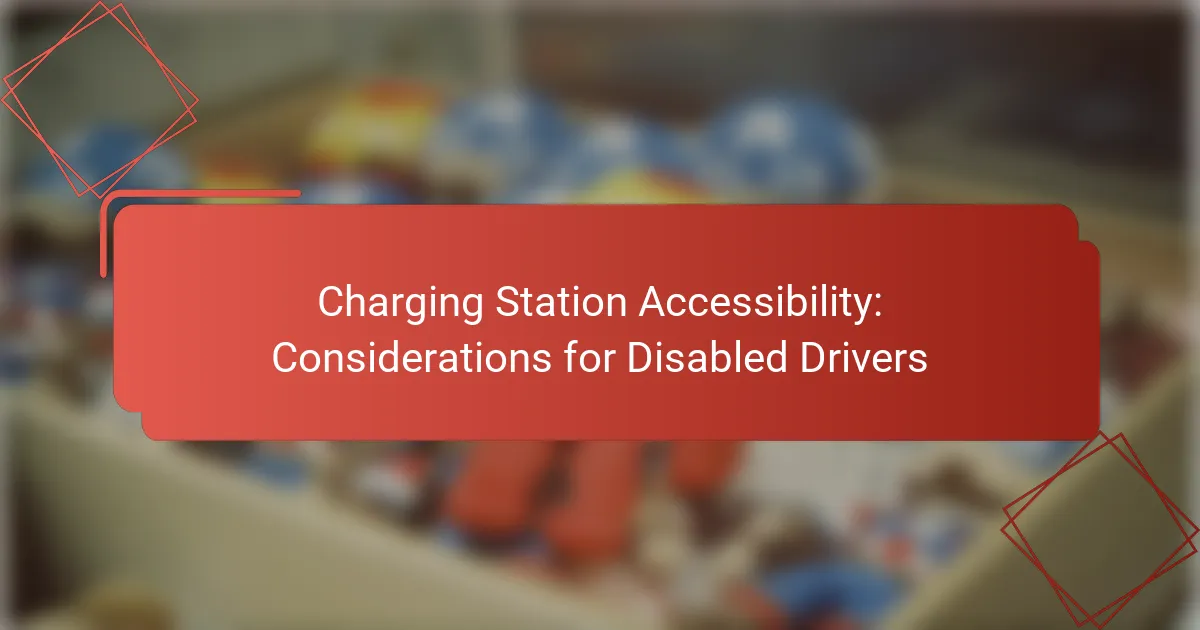Charging station accessibility for disabled drivers is essential for ensuring equal access and usability. Key factors include adherence to ADA regulations, the presence of designated accessible parking spaces, and the availability of user-friendly charging equipment. By implementing thoughtful design and utilizing resources to locate accessible stations, operators can significantly enhance the charging experience for all users.
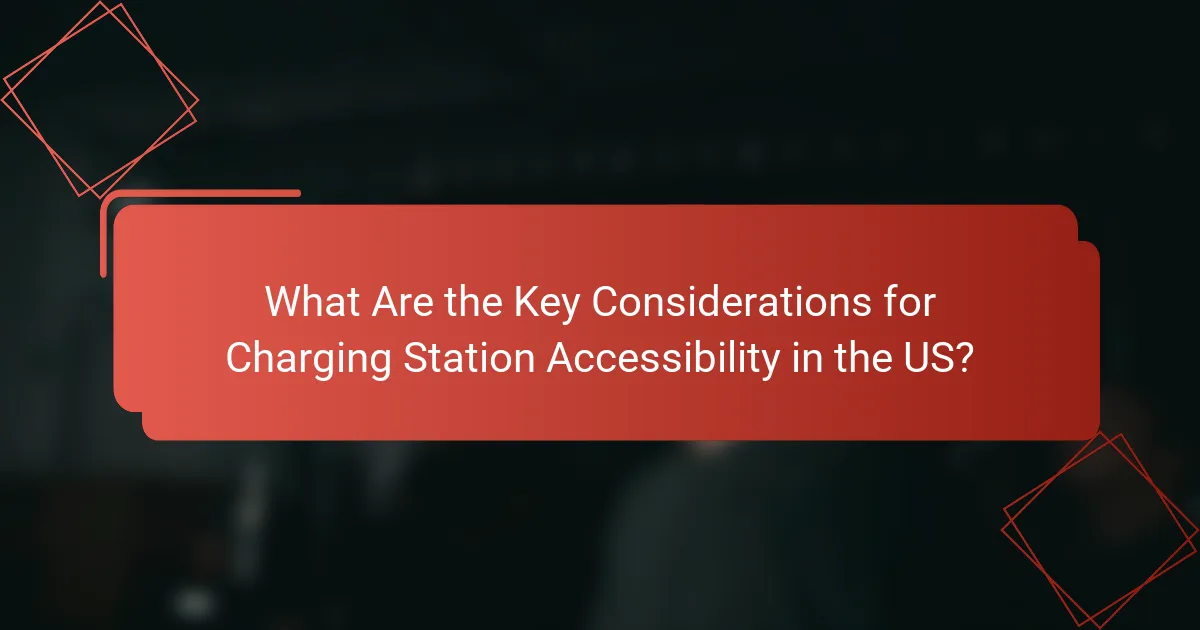
What Are the Key Considerations for Charging Station Accessibility in the US?
Charging station accessibility for disabled drivers involves several critical factors to ensure equal access and usability. Key considerations include compliance with ADA regulations, the availability of designated accessible parking spaces, and the provision of user-friendly charging equipment.
ADA compliance requirements
ADA compliance is essential for charging stations to ensure they are accessible to individuals with disabilities. This includes meeting specific design standards for parking spaces, pathways, and equipment. Facilities must provide accessible routes and features that accommodate various disabilities.
Charging stations should be designed to allow easy access for individuals using wheelchairs or other mobility aids. Regular audits and updates may be necessary to maintain compliance with evolving ADA standards.
Designated accessible parking spaces
Designated accessible parking spaces are crucial for ensuring that disabled drivers can easily access charging stations. These spaces should be located close to the charging equipment and clearly marked with appropriate signage. The number of accessible spaces should comply with local regulations, typically requiring at least one accessible space for every set number of standard spaces.
It’s important to ensure that these spaces are wide enough to accommodate wheelchair access and that they are free from obstructions. Regular maintenance is necessary to keep these areas clear and functional.
Accessible charging equipment
Accessible charging equipment must be user-friendly for individuals with disabilities. This includes features such as adjustable height, tactile buttons, and audio instructions. Charging stations should also accommodate various types of connectors to serve different electric vehicle models.
Consideration should be given to the placement of charging ports, ensuring they are reachable from a seated position. Providing multiple charging options can enhance accessibility for all users.
Clear signage and pathways
Clear signage and unobstructed pathways are vital for guiding disabled drivers to charging stations. Signs should be easy to read and understand, using large fonts and high-contrast colors. Pathways leading to charging stations should be wide, smooth, and free from obstacles.
Incorporating visual and tactile elements can further assist individuals with visual impairments. Regular checks should be conducted to ensure that signage remains visible and pathways are well-maintained.
Emergency assistance options
Emergency assistance options are important for enhancing safety at charging stations. Stations should provide clear information on how to reach help in case of an emergency, such as a breakdown or medical issue. This may include visible emergency contact numbers and accessible communication devices.
Consideration should also be given to the availability of emergency services nearby. Providing a direct line to assistance can give disabled drivers peace of mind while charging their vehicles.
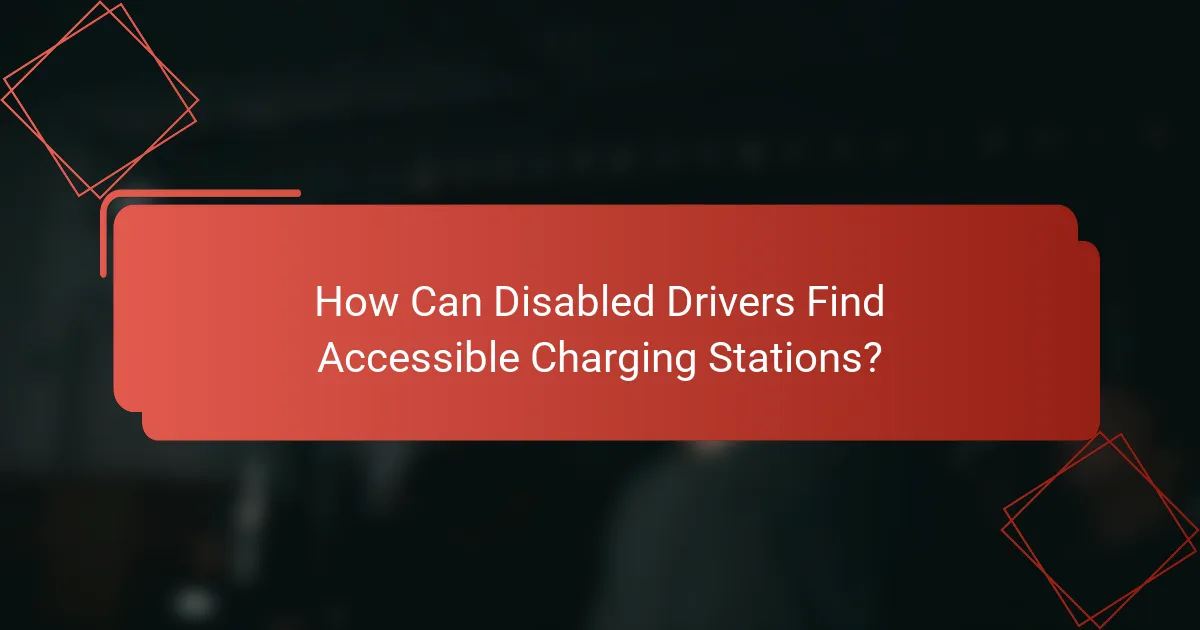
How Can Disabled Drivers Find Accessible Charging Stations?
Disabled drivers can locate accessible charging stations through various tools designed to highlight accessibility features. Utilizing mobile apps, online maps, and community-driven resources can significantly enhance the charging experience for drivers with disabilities.
Mobile apps for locating stations
Several mobile apps cater specifically to the needs of disabled drivers by providing information on accessible charging stations. Apps like PlugShare and ChargePoint allow users to filter results based on accessibility features such as wheelchair access and designated parking spots.
When using these apps, ensure that you check user reviews and comments, as they often contain valuable insights regarding the actual accessibility of the charging stations. Some apps may even allow users to report issues or updates, helping to keep information current.
Online maps with accessibility filters
Online mapping services, such as Google Maps, offer accessibility filters that can help disabled drivers find charging stations. By selecting the “Accessible” option in the filters, users can view locations that meet their specific needs.
It’s advisable to cross-reference multiple sources when planning a route, as not all maps may have the latest data on accessibility features. Additionally, consider checking the station’s official website for detailed information on accessibility services available on-site.
Community-driven resources
Community-driven platforms, such as forums and social media groups, can be invaluable for disabled drivers seeking accessible charging stations. These resources often provide firsthand accounts and tips from other drivers, which can lead to discovering lesser-known but accessible locations.
Engaging with local disability advocacy groups can also yield useful information about charging stations in your area. These organizations may have compiled lists or guides that highlight accessible charging options, ensuring that drivers can charge their vehicles without hassle.

What Are the Best Practices for Charging Station Operators?
Charging station operators can enhance accessibility for disabled drivers by implementing thoughtful design, conducting regular audits, and training staff on accessibility issues. These best practices ensure that charging stations meet the needs of all users, promoting inclusivity and compliance with relevant regulations.
Implementing universal design principles
Universal design principles focus on creating environments that are accessible to everyone, regardless of ability. For charging stations, this means ensuring that charging points are at a height that is reachable for individuals in wheelchairs and providing clear signage that is easy to read.
Operators should also consider the layout of the charging station, ensuring that there is ample space for maneuvering and that pathways are free of obstacles. Incorporating features like tactile paving and audio signals can further assist visually impaired users.
Regular accessibility audits
Conducting regular accessibility audits helps identify barriers that may hinder disabled drivers from using charging stations effectively. These audits should assess the physical layout, signage, and overall user experience, ensuring compliance with accessibility standards.
Operators can engage third-party accessibility consultants to provide an objective evaluation and recommend improvements. Regular audits should be scheduled at least annually to keep facilities up to date with evolving accessibility standards and user needs.
Staff training on accessibility
Training staff on accessibility issues is crucial for providing a welcoming environment for disabled drivers. Employees should be educated on the specific needs of disabled individuals and how to assist them effectively at charging stations.
Training programs can include role-playing scenarios, information on relevant laws, and guidance on how to operate accessible equipment. Ongoing training sessions can help reinforce these principles and ensure that all staff members are equipped to support users with disabilities.
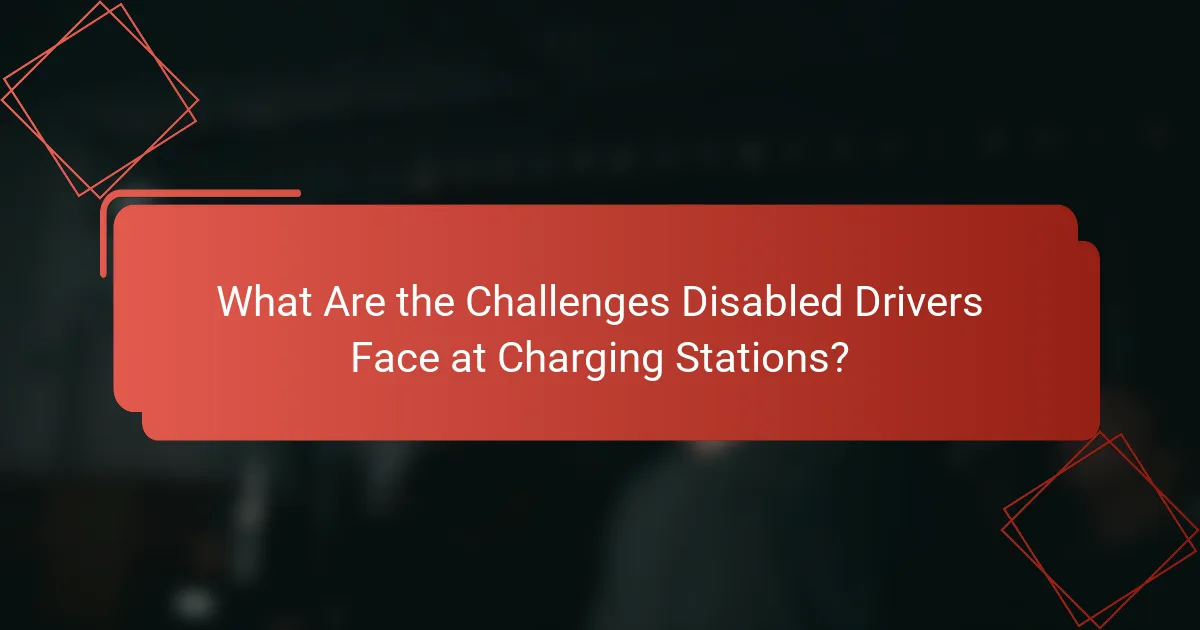
What Are the Challenges Disabled Drivers Face at Charging Stations?
Disabled drivers encounter several challenges at charging stations, primarily due to a lack of accessible facilities, insufficient information on available resources, and physical barriers that hinder their ability to charge their vehicles effectively.
Lack of accessible infrastructure
Many charging stations do not meet accessibility standards, making it difficult for disabled drivers to use them. This includes inadequate parking spaces, poorly designed pathways, and charging units that are not within reach for individuals with mobility impairments.
To improve accessibility, charging station operators should ensure that at least a portion of their stations comply with the Americans with Disabilities Act (ADA) or equivalent local regulations. This includes providing designated accessible parking spots and ensuring that charging equipment is positioned at appropriate heights.
Inadequate information on accessibility
Disabled drivers often struggle to find reliable information about which charging stations are accessible. Many charging networks do not provide detailed descriptions of their facilities, leaving drivers uncertain about where they can safely charge their vehicles.
To address this issue, charging networks should include accessibility information on their websites and mobile apps. This could involve adding features like filters for accessible stations and user-generated reviews that highlight the experiences of disabled drivers.
Physical barriers at charging sites
Physical barriers at charging stations can include uneven surfaces, lack of ramps, and obstructions that make navigation difficult for disabled individuals. These barriers can significantly impact the ability to access charging points safely and efficiently.
To mitigate these challenges, charging station designs should prioritize clear pathways and eliminate obstacles. Regular maintenance is also essential to ensure that surfaces remain even and accessible, allowing all drivers to use the facilities without difficulty.
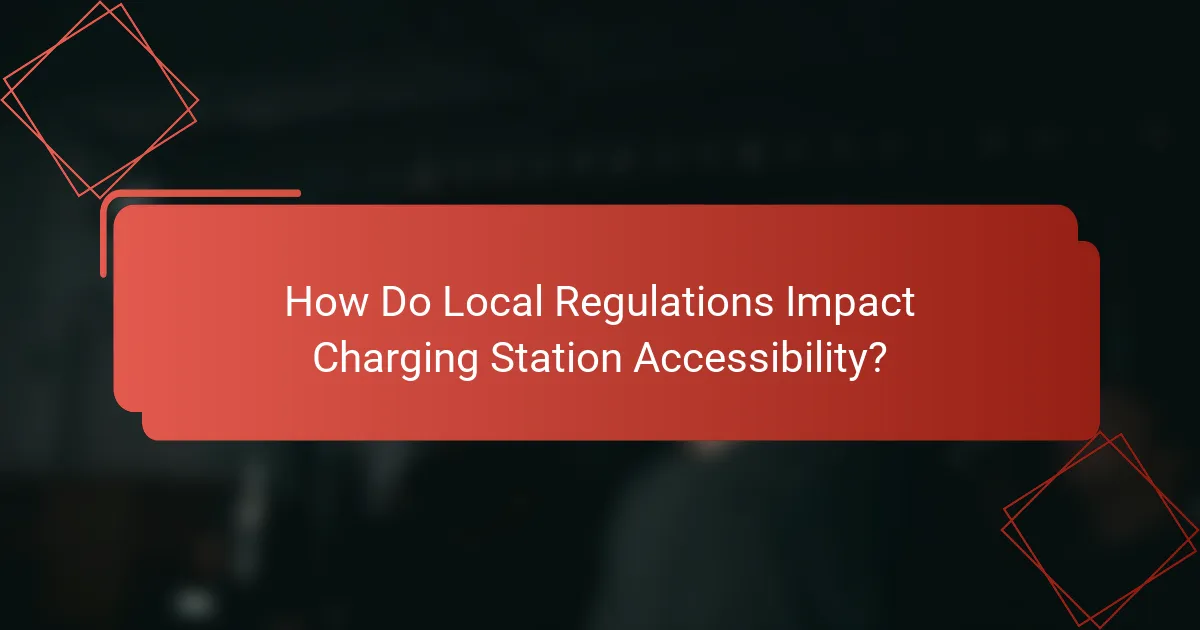
How Do Local Regulations Impact Charging Station Accessibility?
Local regulations play a crucial role in determining the accessibility of charging stations for disabled drivers. These laws can dictate the design, placement, and number of accessible charging points, ensuring that all drivers have equal access to electric vehicle infrastructure.
State-specific accessibility laws
Each state in the U.S. has its own set of accessibility laws that can affect charging station design and placement. For instance, the Americans with Disabilities Act (ADA) sets minimum standards, but states may implement additional requirements to enhance accessibility. This can include specific signage, wider parking spaces, and accessible pathways.
Some states may require that a certain percentage of charging stations be accessible, while others may not have explicit mandates. It’s essential for charging station operators to familiarize themselves with local laws to ensure compliance and provide adequate facilities for disabled drivers.
For example, California has stringent regulations that often exceed federal standards, requiring more accessible charging stations in urban areas. Operators should regularly check for updates to these laws to maintain compliance and improve accessibility for all users.
